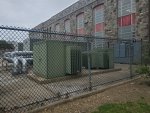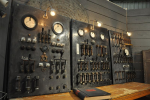zemingduan
Senior Member
- Location
- Philadelphia,PA
- Occupation
- Electrical Designer
I'm so confused about the term "live part or the exposed live part" when determine working space and distance in according to NEC 2017 110.26(A)(1), 110.31 & 110.34(A).
I see the definition of live and exposed live part in NEC, but I am still confused. What is the insight of which equipment/conductors is considered as "live or exposed live part" ?
If a disconnect switch is supplied from a feeder rather a service conductors, which means you can deenergize this switch through supply side disconnect, is it still considered as live part? For example, a 100A elevator non-fused disconnect switch next to the elevator motor supplied from a fused disconnect switch in electrical room, is the non-fused disconnect switch live or exposed live part?
Is a service rated meter bank with 800A MCB supplied from service conductors live or exposed live part?
Is a 2.4 KV outdoor safety switch with handle to shut it off in school campus supplied from MV feeder from a main switchgear considered as live part or exposed live part?
Is an enclosed transformer(not utility transformer) considered as live or exposed live part? I think I doesn't requires testing or inspection when it is energized. Thus it's not a live part.
Very appreciate you guys helping me to understand this.
I see the definition of live and exposed live part in NEC, but I am still confused. What is the insight of which equipment/conductors is considered as "live or exposed live part" ?
If a disconnect switch is supplied from a feeder rather a service conductors, which means you can deenergize this switch through supply side disconnect, is it still considered as live part? For example, a 100A elevator non-fused disconnect switch next to the elevator motor supplied from a fused disconnect switch in electrical room, is the non-fused disconnect switch live or exposed live part?
Is a service rated meter bank with 800A MCB supplied from service conductors live or exposed live part?
Is a 2.4 KV outdoor safety switch with handle to shut it off in school campus supplied from MV feeder from a main switchgear considered as live part or exposed live part?
Is an enclosed transformer(not utility transformer) considered as live or exposed live part? I think I doesn't requires testing or inspection when it is energized. Thus it's not a live part.
Very appreciate you guys helping me to understand this.



